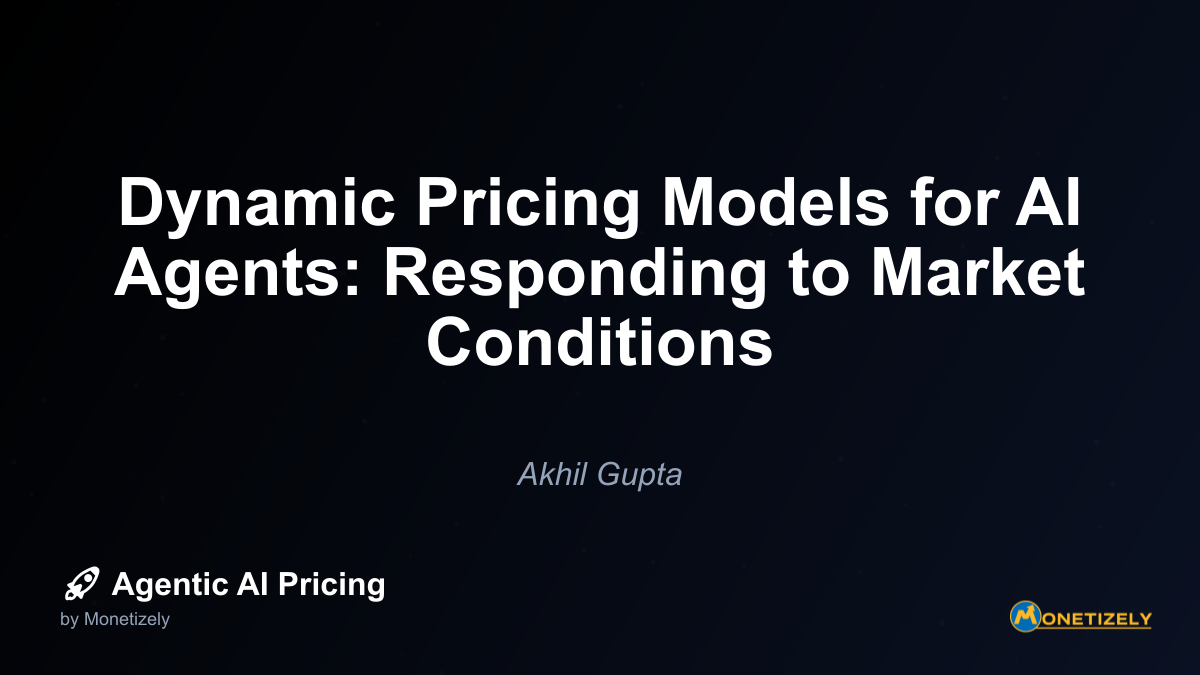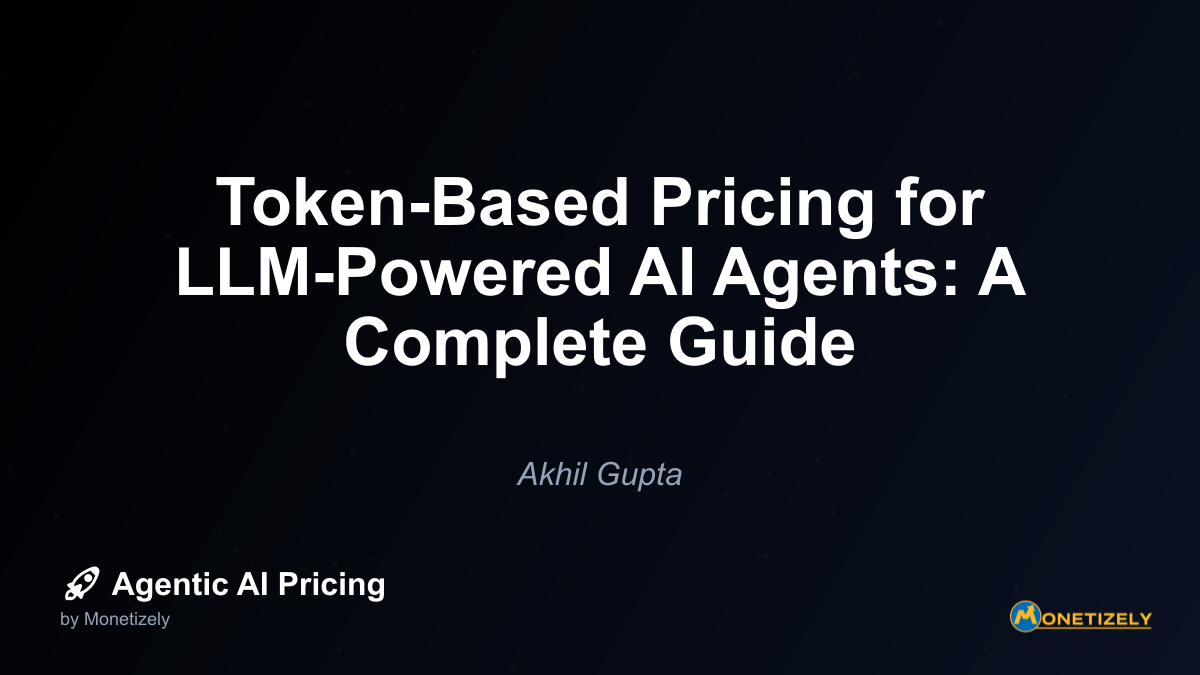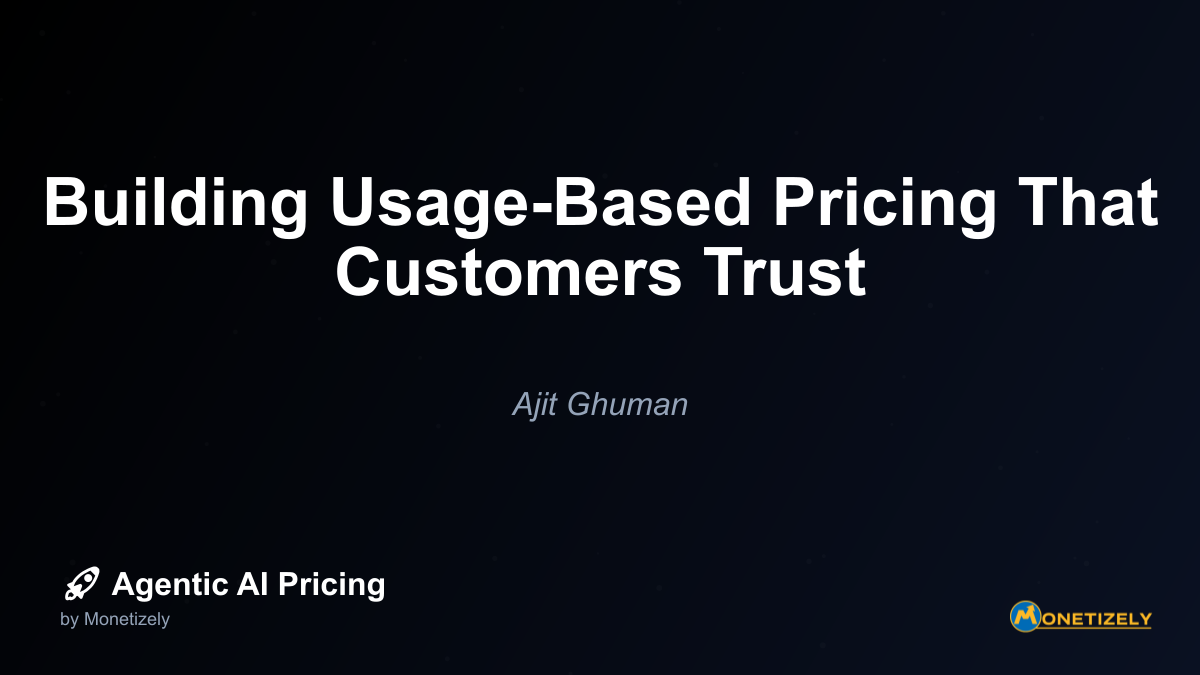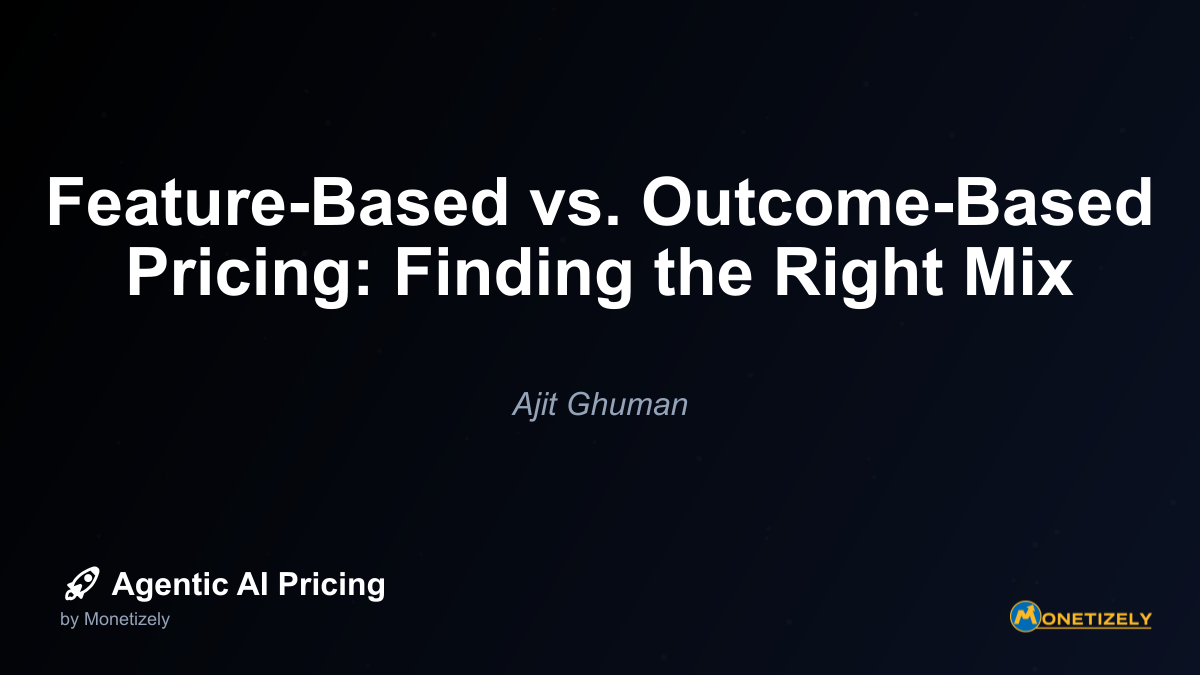· Ajit Ghuman · AI Pricing Models · 14 min read
Pricing Multi-Agent Systems: Approaches for Agent Ecosystems
AI and SaaS Pricing Masterclass
Learn the art of strategic pricing directly from industry experts. Our comprehensive course provides frameworks and methodologies for optimizing your pricing strategy in the evolving AI landscape. Earn a professional certification that can be imported directly to your LinkedIn profile.
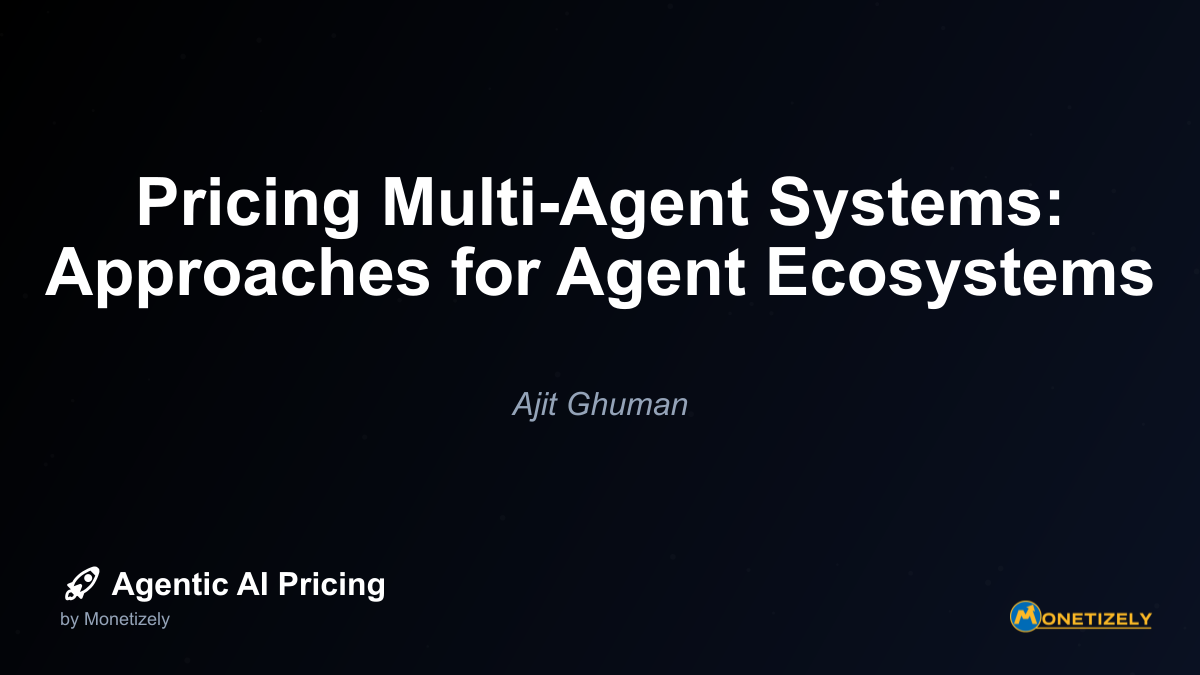
In the rapidly evolving landscape of artificial intelligence, multi-agent systems represent one of the most transformative developments for enterprises seeking to deploy AI at scale. These interconnected ecosystems of specialized AI agents working collaboratively offer unprecedented capabilities—but also introduce novel challenges for pricing and monetization. As organizations transition from standalone AI tools to sophisticated agent networks, traditional pricing approaches are proving inadequate for capturing value and aligning costs with outcomes.
The Evolution from Single Agents to Multi-Agent Ecosystems
The transition from isolated AI agents to collaborative multi-agent systems represents a fundamental shift in how artificial intelligence delivers value. Single agents, while powerful in focused domains, operate within defined boundaries and typically handle discrete tasks with limited context. Multi-agent systems, by contrast, create emergent capabilities through collaboration, specialization, and orchestrated workflows.
This evolution mirrors the progression we’ve seen in human organizational structures—from individual contributors to specialized teams working in concert. The value proposition shifts accordingly, from task completion to complex process orchestration and decision-making ecosystems that can tackle multifaceted business challenges.
According to recent market data, the global AI agent market is projected to grow from approximately $5.1 billion in 2024 to $47.1 billion by 2030, representing a compound annual growth rate of nearly 45%. North America currently dominates with roughly 40% market share, though adoption is accelerating globally across industries.
The shift toward multi-agent architectures is particularly pronounced in enterprise environments. Research indicates that approximately 25% of generative AI users will pilot agentic systems by 2025, with that number expected to double by 2027. This rapid adoption is driven by compelling performance metrics, including up to 50% efficiency improvements in areas like customer service, sales operations, and human resources.
Understanding the Value Dimensions of Multi-Agent Systems
Before exploring pricing strategies, it’s essential to understand the distinct value dimensions that multi-agent systems deliver:
1. Emergent Intelligence Through Collaboration
Multi-agent systems derive significant value from their collaborative capabilities. Rather than simply adding up the contributions of individual agents, these systems create emergent intelligence through agent interactions, problem decomposition, and specialized handling of subtasks. This collaborative framework enables tackling complex problems that would overwhelm single agents.
For example, in financial services, multi-agent systems for investment analysis might include specialized agents for data collection, market trend analysis, risk assessment, and portfolio optimization—each contributing expertise while collectively generating insights no single agent could produce alone.
2. Adaptability and Resilience
Multi-agent architectures inherently offer greater adaptability and resilience than monolithic alternatives. When business requirements change or new capabilities are needed, organizations can add, remove, or reconfigure agents without rebuilding entire systems. This modularity creates significant long-term value through reduced technical debt and greater business agility.
3. Scalability Across Domains
As enterprises expand AI implementations across departments and functions, multi-agent systems provide natural scalability. New domains can be addressed by adding specialized agents while leveraging existing infrastructure, knowledge bases, and orchestration capabilities. This cross-domain scalability represents substantial value, particularly for organizations pursuing enterprise-wide AI transformation.
4. Reduced Operational Complexity
Despite their technical sophistication, well-designed multi-agent systems can significantly reduce operational complexity for end-users. By handling coordination internally and presenting unified interfaces, these systems can mask underlying complexity while delivering sophisticated capabilities—transforming how organizations approach complex processes.
Core Pricing Approaches for Multi-Agent Systems
The unique characteristics of multi-agent systems necessitate rethinking traditional software pricing models. Several approaches have emerged as particularly effective for capturing value while aligning with customer expectations and usage patterns:
1. Agent Assembly Pricing
Agent assembly pricing represents one of the most innovative approaches specifically designed for multi-agent environments. This modular pricing framework typically includes:
- Base Platform Fee: Covering the orchestration layer, integration capabilities, and foundational infrastructure
- Per-Agent Licensing: Tiered pricing for different agent types based on capabilities and specialization
- Integration Premiums: Additional fees for connecting to enterprise systems, data sources, or third-party services
- Scale-Based Components: Variable pricing tied to usage volume, concurrent processes, or other scale metrics
This approach allows organizations to tailor multi-agent deployments to their specific needs while creating predictable cost structures that scale with value delivery. As one product lead at ServiceNow AI Products noted, “Our pricing model considers not only the AI usage but the integration depth and ongoing management costs of the multi-agent environment—complexity grows, so does customization and support.”
2. Outcome-Based Pricing
Outcome-based pricing ties costs directly to measurable business results rather than technical inputs or consumption metrics. This approach has gained significant traction, with adoption rates approximately 30% higher than traditional subscription models according to recent industry data.
Under outcome-based models, organizations pay based on verifiable outcomes such as:
- Revenue increases or cost reductions attributable to the system
- Productivity improvements measured through time savings or throughput gains
- Error reduction or quality improvements in key business processes
- Customer satisfaction or engagement metrics
This approach aligns incentives between providers and customers while focusing on business value rather than technical implementation details. It’s particularly effective for multi-agent systems where the value often exceeds the sum of individual components.
As noted by an AI Product Director at Salesforce, “When customers see a direct lift in conversion and operational savings, we tailor pricing to ensure alignment with ROI, promoting wider adoption of multi-agent AI.”
3. Consumption-Based Pricing
Drawing inspiration from cloud computing models, consumption-based pricing for multi-agent systems ties costs to resource utilization metrics such as:
- Token processing volume across agents
- Compute time or GPU/CPU utilization
- Storage requirements for knowledge bases and contextual data
- API call volume or throughput metrics
This approach provides scalability while maintaining cost predictability, allowing organizations to start small and expand as value is demonstrated. It’s particularly well-suited for multi-agent deployments where usage may vary significantly over time or across departments.
4. Value-Tiered Subscription Models
Value-tiered subscription models segment offerings based on capability levels, typically ranging from basic implementations to enterprise-grade solutions with advanced features. For multi-agent systems, these tiers often reflect:
- Agent diversity and specialization available within the ecosystem
- Orchestration capabilities and workflow complexity
- Integration depth with enterprise systems
- Customization options and domain-specific optimizations
- Support levels and implementation assistance
This approach enables market segmentation while creating natural upgrade paths as organizations realize value and seek expanded capabilities. Industry-specific tiers can further enhance relevance for sectors with unique requirements or regulatory considerations.
Case Studies: Multi-Agent Pricing in Action
Examining real-world implementations provides valuable insights into how organizations are approaching multi-agent pricing in practice:
ServiceNow and Microsoft’s Collaborative Incident Management
ServiceNow and Microsoft developed multi-agent AI systems for enterprise IT incident management, creating a collaborative environment where agents from Microsoft Copilot and ServiceNow’s NowAssist coordinate to manage complex P1 incidents. The system handles incident transcription, action recommendation, and continuous learning from events.
Pricing Approach: While specific pricing details aren’t public, the implementation leverages a hybrid model combining enterprise platform licensing with AI orchestration tools. Costs scale based on usage complexity and integration depth, reflecting the sophisticated nature of cross-platform agent collaboration.
Results: The implementation significantly improved collaboration between platforms and reduced time to resolve critical IT incidents by shifting from slow human coordination to streamlined AI orchestration.
H&M’s Virtual Shopping Assistant
H&M implemented a virtual shopping assistant leveraging a multi-agent architecture to manage personalized recommendations, frequently asked questions, and purchase guidance. This effectively functions as a multi-agent system with different components handling distinct aspects of the customer journey.
Pricing Approach: Though exact pricing isn’t public, typical deployments in this domain use subscription or usage-based models scaled by conversation volume or active user counts, with additional costs for customization and integration.
Results: The implementation delivered impressive metrics, including 70% autonomous resolution of customer queries, a 25% increase in conversion rates during chatbot sessions, and 3× faster customer response times. These outcomes justified the investment through both cost savings and revenue enhancement.
IBM’s AIOps for IT Operations
IBM deployed multi-agent AI systems for IT operations, focusing on alert noise reduction, event correlation, and automated remediation recommendations. The implementation uses specialized agents for different filtering and analysis tasks within IT incident management workflows.
Pricing Approach: IBM typically offers AIOps solutions through enterprise subscription models, with costs tied to the volume of monitored infrastructure resources and AI service usage. This approach balances predictability with scalability for enterprise customers.
Results: The implementation improved system reliability, accelerated incident detection and remediation, and reduced alert fatigue for IT teams—delivering tangible operational benefits while enhancing service quality.
Technical Considerations Impacting Pricing Decisions
Several technical factors directly influence pricing strategy for multi-agent systems:
Coordination Complexity and Orchestration Overhead
Multi-agent systems require sophisticated orchestration layers to manage agent interactions, workflow execution, and conflict resolution. This coordination complexity introduces additional computational overhead and development costs that must be factored into pricing models.
For organizations developing or deploying multi-agent systems, the orchestration layer often represents a significant portion of both initial investment and ongoing operational costs. Pricing strategies must account for this complexity, particularly for systems with many specialized agents or complex interaction patterns.
Infrastructure Requirements and Scaling Considerations
The distributed nature of multi-agent systems creates distinct infrastructure requirements that impact cost structures:
Compute Resources: Multi-agent systems typically require substantial compute resources to support concurrent, distributed agent execution—particularly when agents leverage large language models or reinforcement learning components. Hybrid deployments across cloud and edge nodes are increasingly common to optimize for latency and cost.
Communication Frameworks: Robust inter-agent communication requires specialized frameworks such as event-driven architectures, shared memory repositories, or state management tools. These components add both development and operational costs.
Monitoring and Logging Systems: Comprehensive monitoring across distributed agent networks is essential for performance optimization, compliance, and issue resolution. These systems add infrastructure costs that scale with deployment complexity.
As a senior AI strategist at Microsoft Research noted, “Pricing multi-agent systems is not just about CPU cycles and API calls. It’s about the value created by orchestration—how these agents work together to solve business-critical challenges faster and more accurately.”
Integration Depth and Customization Needs
Multi-agent systems typically require deeper enterprise integration than standalone AI tools, connecting to multiple data sources, business systems, and workflow engines. This integration depth introduces implementation costs that vary significantly based on:
- Number and complexity of integration points
- Data transformation and synchronization requirements
- Authentication and security considerations
- Custom workflow development needs
- Enterprise system compatibility challenges
Pricing models must account for these integration costs, particularly for complex enterprise deployments. Many organizations adopt hybrid pricing approaches that separate base platform costs from implementation and integration services.
Pricing Challenges Specific to Multi-Agent Systems
Several challenges uniquely impact pricing strategy for multi-agent systems:
1. Attributing Value Across Agent Ecosystems
In multi-agent environments, value creation often occurs through agent collaboration rather than individual agent actions. This collaborative value generation complicates traditional approaches to feature-based or component pricing.
Organizations must determine how to attribute value across the agent ecosystem—particularly when different agents are developed by different teams or vendors. This challenge becomes especially acute in outcome-based pricing models where determining causality between specific agents and business outcomes may not be straightforward.
2. Balancing Flexibility and Complexity
Multi-agent systems derive significant value from their flexibility and adaptability. However, creating pricing models that preserve this flexibility without introducing excessive complexity represents a significant challenge.
Too rigid pricing can constrain the very flexibility that makes multi-agent systems valuable, while overly complex models create friction in the sales process and may deter adoption. Finding the balance between flexibility and simplicity requires careful consideration of customer preferences, competitive dynamics, and operational constraints.
3. Managing Cost Predictability
The dynamic nature of multi-agent systems can create challenges for cost predictability—both for providers and customers. Usage patterns may change as agents evolve or new capabilities are added, potentially leading to unexpected cost increases under consumption-based models.
Organizations must design pricing approaches that provide reasonable predictability while accommodating the inherent dynamism of multi-agent environments. This often involves implementing usage caps, tiered pricing structures, or hybrid models that combine fixed and variable components.
4. Accounting for Ongoing Evolution
Multi-agent systems typically evolve continuously as new agents are added, existing agents are enhanced, or orchestration capabilities expand. This ongoing evolution creates challenges for traditional pricing approaches designed around stable feature sets.
Effective pricing strategies must accommodate this evolutionary nature, creating structures that can adapt as the system grows in capability and complexity. This often involves designing modular pricing components that can be adjusted independently as the system evolves.
Strategic Pricing Frameworks for Multi-Agent Systems
Building on the approaches and considerations discussed, several strategic frameworks have emerged for pricing multi-agent systems:
The Modular Value Framework
The Modular Value Framework decomposes multi-agent pricing into distinct components aligned with different value dimensions:
- Foundation Layer: Base pricing for the orchestration platform, core infrastructure, and fundamental capabilities
- Agent Layer: Incremental pricing for each agent based on capability level and specialization
- Integration Layer: Pricing for connections to enterprise systems, data sources, and third-party services
- Scale Layer: Variable pricing tied to usage volume, user counts, or other scaling metrics
- Outcome Layer: Performance-based components tied to measurable business outcomes
Organizations can emphasize different layers based on their market position, competitive landscape, and customer preferences. This modular approach provides flexibility while maintaining conceptual clarity for both internal teams and customers.
The Ecosystem Adoption Framework
The Ecosystem Adoption Framework focuses on accelerating adoption and expansion of multi-agent deployments through strategically designed pricing incentives:
- Entry Pricing: Low-friction pricing for initial deployments, often focused on specific use cases or departments
- Expansion Incentives: Pricing structures that encourage adding agents or expanding use cases through decreasing marginal costs
- Enterprise Consolidation: Volume-based discounting and simplified pricing for organization-wide deployments
- Partner Integration: Special pricing for integrations with strategic partners or complementary services
- Community Contribution: Incentives for customers who contribute to agent development or share implementation insights
This framework is particularly effective for organizations seeking to establish market leadership in emerging multi-agent categories or those competing against entrenched alternatives.
The Value Realization Framework
The Value Realization Framework aligns pricing directly with customer value realization through a staged approach:
- Discovery Pricing: Low-cost or free evaluation periods focused on proving concept viability
- Implementation Pricing: Cost structures for initial deployment, integration, and customization
- Adoption Pricing: Pricing tied to user adoption metrics and engagement patterns
- Value Capture: Performance-based components that scale as measurable business value is delivered
- Transformation Pricing: Enterprise-wide pricing for strategic deployments driving organizational transformation
This framework creates natural alignment between costs and value realization while providing customers with a clear path from initial experimentation to transformative implementation.
Competitive Approaches and Market Positioning
Major technology providers are taking distinct approaches to multi-agent pricing, reflecting their market positions and strategic priorities:
OpenAI’s API-Centric Approach
OpenAI has primarily focused on consumption-based API pricing for their models, with costs tied directly to token usage and model size. For multi-agent implementations, this translates to aggregated consumption across agents, with customers bearing orchestration and integration costs.
This approach maximizes flexibility while shifting implementation complexity to customers or integration partners. It’s particularly well-suited for OpenAI’s position as an infrastructure provider rather than an end-to-end solution developer.
Microsoft’s Enterprise Platform Strategy
Microsoft has integrated multi-agent capabilities into their broader enterprise platforms, particularly through Microsoft Copilot and Azure AI services. Their pricing typically combines enterprise licensing with consumption-based components, leveraging existing customer relationships and integration with Microsoft’s ecosystem.
This approach emphasizes enterprise-wide value and integration with existing Microsoft investments. It’s designed to accelerate adoption within Microsoft’s installed base while creating switching costs that reduce competitive threat.
Google’s Vertex AI Agent Builder Approach
Google has positioned Vertex AI Agent Builder as a comprehensive platform for developing and deploying multi-agent systems. Their pricing combines platform licensing with consumption-based components and optional managed services for implementation and optimization.
This approach balances flexibility with accessibility, providing options for both technical teams building custom solutions and business users seeking faster deployment. It reflects Google’s strategy of competing on technical capability while improving accessibility for non-technical users.
Salesforce’s Industry Solution Strategy
Salesforce has focused on industry-specific multi-agent solutions integrated with their CRM and customer experience platforms. Their pricing typically combines platform licensing with industry-specific components and outcome-based elements tied to customer success metrics.
This approach emphasizes immediate business value and industry relevance rather than technical flexibility. It’s designed to appeal to business leaders seeking proven solutions for industry-specific challenges rather than custom development platforms.
Emerging Pricing Trends and Future Directions
Several emerging trends are likely to shape multi-agent pricing over the next 2-3 years:
1. Increased Emphasis on Outcome-Based Components
As multi-agent systems mature and their business impact becomes more measurable, outcome-based pricing components are likely to gain prominence. This shift reflects growing customer sophistication and demand for alignment between costs and business value.
Organizations will increasingly incorporate performance-based elements into their pricing models, particularly for enterprise deployments where business outcomes can be clearly defined and measured. This trend will accelerate as more case studies demonstrate quantifiable ROI from multi-agent implementations.
2. Ecosystem-Aware Pricing Models
As multi-agent ecosystems expand beyond individual vendors, pricing models will evolve to accommodate multi-vendor deployments and marketplace dynamics. This may include:
- Revenue-sharing mechanisms for collaborative agent development
- Marketplace models for specialized agents from different providers
- Standardized pricing components for common agent types or capabilities
- Interoperability premiums for agents designed to work across platforms
These ecosystem-aware approaches will support the growing diversity of multi-
Co-Founder & CEO
Ajit is the author of Price To Scale, a top book on SaaS Pricing and is the Founder of Monetizely. Ajit has led and worked in pricing and product marketing at firms like Twilio, Narvar and Medallia. His work has been featured in Forbes and VentureBeat. Ajit regularly consults with software companies from Seed stage to post-IPO on pricing strategy. Ajit is also a highly-rated co-instructor for 'The Art of SaaS Pricing and Monetization' on Maven.
Pricing Strategy Audit
Let our experts analyze your current pricing strategy and identify opportunities for improvement. Our data-driven assessment will help you unlock untapped revenue potential and optimize your AI pricing approach.

